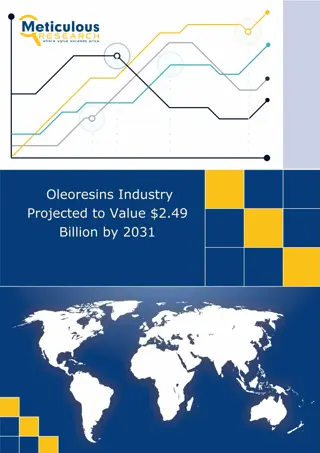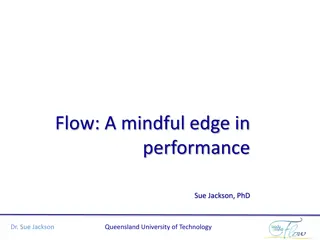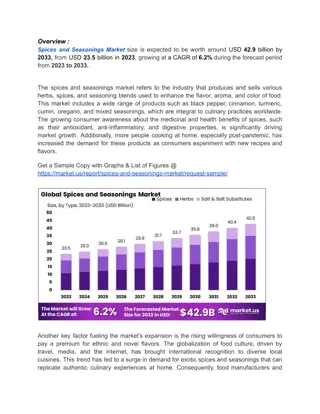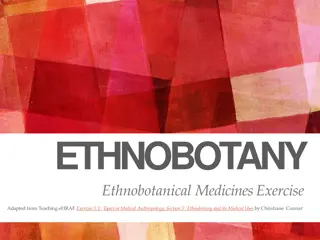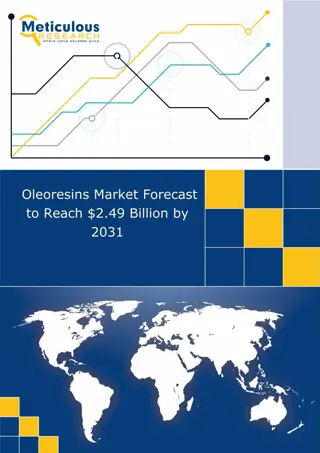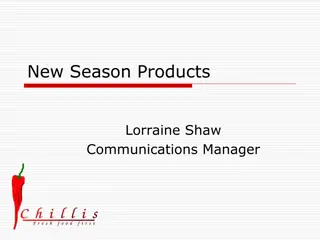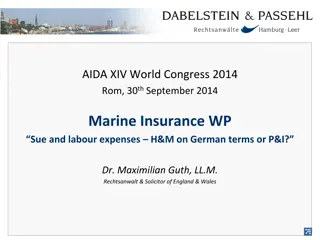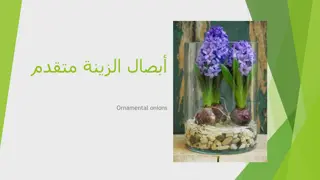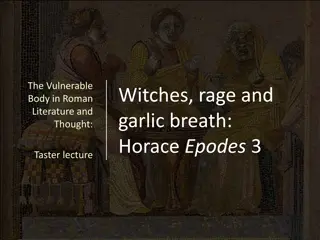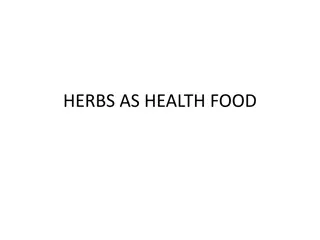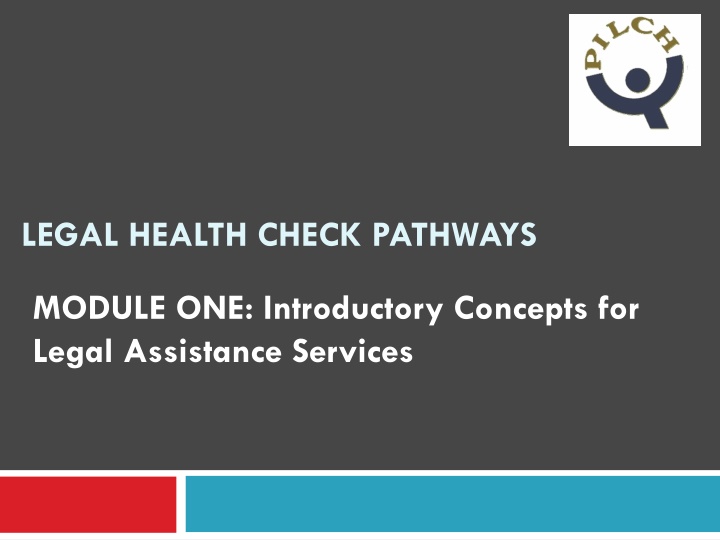
Legal Health Check Pathways and Assistance Services
Explore introductory concepts of legal health check pathways and services, including the basics, benefits, change possibilities, and worth. Learn about the DJAG LHC Project 2014-16, its background, phases, pilot sites, and available resources. Understand the definitions of legal need and actual legal need in vulnerable client clusters. Dive into stories from QPILCH pilot sites and NT, along with the significance of recognizing legal problems within disadvantaged groups.
Download Presentation

Please find below an Image/Link to download the presentation.
The content on the website is provided AS IS for your information and personal use only. It may not be sold, licensed, or shared on other websites without obtaining consent from the author. If you encounter any issues during the download, it is possible that the publisher has removed the file from their server.
You are allowed to download the files provided on this website for personal or commercial use, subject to the condition that they are used lawfully. All files are the property of their respective owners.
The content on the website is provided AS IS for your information and personal use only. It may not be sold, licensed, or shared on other websites without obtaining consent from the author.
E N D
Presentation Transcript
LEGAL HEALTH CHECK PATHWAYS MODULE ONE: Introductory Concepts for Legal Assistance Services
Introductory Concepts 1. Legal Health Check Basics 2. What are LHCs good for at a Legal Assistance service? 3. What can you change? 4. Is it worth it?
1. Legal Health Check Basics DJAG LHC Project 2014-16 www.legalhealthcheck.org.au Stories Definitions
DJAG LHC Project 2014-16 Background: Since 2009, BYS/L&JF etc-Roma House-sharing thinking-LAQ videos-NACLC videos-QCOSS launch-ongoing feedback Phases: QPILCH evaluation Pilot sites evaluation Pilots: o Maroochydore : Suncoast Legal, LAQ, Sunnykids (DV) o Toowoomba: TASC, Red Cross Homestay (Mental health and disability) o Cairns: ATSILS, Wuchopperen (Indigenous) Products: Best practice guidelines and training for Legal Assistance Services/ Update resources / Evaluation report
www.legalhealthcheck.org.au Resources/four tutorial videos for community workers NACLC/QPILCH site 40+ CLCs around Australia
Stories QPILCH Pilot sites NT others
Definitions Legal Need= requires any access to justice response, such as resources, advocacy, advice or representation. Actual Legal Need= the recognised AND unrecognised clustered legal needs of vulnerable clients Some sections of the community are more vulnerable to legal problems than others 9% of Australians account for approximately 65% of legal problems Legal problems more prevalent among socially disadvantaged groups, and these individuals tend to have lower capability to resolve legal problems Legal problems are clustered with other legal problems and with non-legal problems Not likely to recognize the issue as a legal problem or seek help from a lawyer. May seek help from non-lawyer, such as health and community worker. Coumarelos C, et al, Legal Australia-Wide Survey: legal need in Australia (2012) Law and Justice Foundation of NSW, Sydney
Collaborative Service Planning ...to most efficiently and effectively assist those with the disproportionate amount of legal need, services should be increasingly client-focused, that is: Targeted to reach those with the highest need and lowest capability Joined up with other services to address complex life problems Timely to minimise the impact of problems and maximise the utility of services Appropriateto the needs and capabilities of users. Collaborative Planning Resource-Service Planning 2015 Law and Justice Foundation
2. What are LHCs good for? (at a LAS) 2.1 Who are your potential clients and what are their actual legal needs? 2.2 What are the actual legal needs of your existing clients? 2.3 Do you want community agencies to connect their clients to you? 2.4 Do you want community agencies to diagnose their clients actual legal need?
2.1.Who are your potential clients and what are their needs? Fig.1 ACTUAL LEGAL NEEDS THE PATH TO YOUR DOOR DEBT HOUSE What the client knows and can do CRIME Legal Assistance Service Centre-based Outreach Embedded LHC offers: -clarify range of legal issues -grouping of issues -Endemic add-on issues ( DV + ) INCOME DECISIONS FAMILY FINES
2.2. What are the actual legal needs of existing clients? Fig.2 ACTUAL LEGAL NEEDS THE PATH TO YOUR DOOR DEBT What the client knows and can do HOUSE CRIME LEGAL ASSISTANCE SERVICE Centre-based Outreach Embedded + Just-in-time CLE INCOME LHC offers CLE: -process focussed -for workers DECISIONS FAMILY -Client awareness of DV+ FINES
2.3. Do you want community agencies to connect their clients? Fig.3 ACTUAL LEGAL NEEDS THE PATH TO YOUR DOOR DEBT What the client knows and can do HOUSE CRIME LEGAL ASSISTANCE SERVICE Centre-based Outreach Embedded + Just-in-time CLE INCOME DECISIONS +Community worker engagement FAMILY LHC offers: -Relationships & Communication -Referral frameworks -Training -Resources FINES
2.4. Do you want community agencies to diagnose their clients? Fig.4 ACTUAL LEGAL NEEDS THE PATH TO YOUR DOOR DEBT HOUSE What the client knows and can do CRIME LEGAL ASSISTANCE SERVICE Centre-based Outreach Embedded INCOME + Just-in-time CLE DECISIONS +Community worker engagement FAMILY FINES +LHC is assessment tool at community agency CLC #2
3. What can you change? Better to provide: a more systematic diagnosis of a client's full range of legal and non-legal needs at entry, followed by a case plan for addressing all of those needs through coordinated response across all services Vulnerable clients require an assertive/persistent/wholistic/coordinated response (c.f. self-help, one-off or advice) More Effective Social Services: Report of NZ Productivity Commission August 2015
3. What can you change? Task One: LAS Service Spectrum What do you currently offer to your most vulnerable clients?
Legal assistance service spectrum Information, Community Legal Education and Community Development: Information about the law Representation: I speak for you before a court, tribunal, or during a mediation I may be a barrister instructed by a solicitor instructed by you Eligibility criteria and intake processes? -legal issue -client vulnerability Advice: I can advise you about how the law applies in your situation Casework: I advise, write letters and negotiate on your behalf Referral to other legal services: I ll connect you to more appropriate lawyers and advocates Duty lawyer: I speak for you at this hearing today only Small task assistance: I can help with this specific task Law reform: Let s try to change this for everyone impacted
3. What can you change? Task Two: Which LHC is relevant? What legal issues do your existing clients have? Use your experience/casework statistics/assumptions/networks. Also consider other legal needs diagnosis tool, e.g NACLC Legal Needs Strategic Planning Toolkit or emerging L&J tools
3. What can you change? Task Three: What is one change you can make? Strategic, assertive targeting of issues? (DV+) Warmer referrals? Collaboration protocol with other LAS ( LegalPod and LAQ Child Protection) Form filling or discrete task assistance Protocol with problem agency e.g. SPER 58% of HPLC clients had a SPER issue identified using an LHC, whereas only 8% of clients asked about SPER
3. What can you change? Task Four: How might this make a difference for your client? Story Canadian research
4. Is it worth it? Findings from evaluation Lit review summary Updates from around Australia In short: A LHC can guide the non-legal practitioner, when they are with the client, as to what to say and what to do, about their client s legal needs What do you want to do in response to that ? (Guidelines are next module)
LHC Evaluation (phase one) 2015 Does the LHC help in QPILCH settings? Good concept, good document and good questions Works best if actually complete form (3.5 vs. 1.5 legal issues per client) Appears to influence community workers to engage with legal service and prioritise support for client which influences favourable outcomes for clients BUT busy lawyers and busy community workers rarely use form (could be result of entrenched LHC approach )


![[✔PDF✔⚡] Renal Diet Cookbook for the Newly Diagnosed: The Complete Guide to](/thumb/68079/pdf-renal-diet-cookbook-for-the-newly-diagnosed-the-complete-guide-to.jpg)

